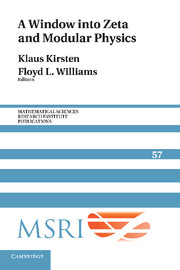Book contents
- Frontmatter
- Contents
- Introduction
- Lectures on zeta functions, L-functions and modular forms with some physical applications
- Basic zeta functions and some applications in physics
- Zeta functions and chaos
- Vertex operators and modular forms
- Applications of elliptic and theta functions to Friedmann–Robertson–Lemaître–Walker cosmology with cosmological constant
- Integrable systems and 2D gravitation: How a soliton illuminates a black hole
- Functional determinants in higher dimensions using contour integrals
- The role of the Patterson–Selberg zeta function of a hyperbolic cylinder in three-dimensional gravity with a negative cosmological constant
Basic zeta functions and some applications in physics
Published online by Cambridge University Press: 29 May 2025
- Frontmatter
- Contents
- Introduction
- Lectures on zeta functions, L-functions and modular forms with some physical applications
- Basic zeta functions and some applications in physics
- Zeta functions and chaos
- Vertex operators and modular forms
- Applications of elliptic and theta functions to Friedmann–Robertson–Lemaître–Walker cosmology with cosmological constant
- Integrable systems and 2D gravitation: How a soliton illuminates a black hole
- Functional determinants in higher dimensions using contour integrals
- The role of the Patterson–Selberg zeta function of a hyperbolic cylinder in three-dimensional gravity with a negative cosmological constant
Summary
1. Introduction
It is the aim of these lectures to introduce some basic zeta functions and their uses in the areas of the Casimir effect and Bose–Einstein condensation. A brief introduction into these areas is given in the respective sections; for recent monographs on these topics see [8; 22; 33; 34; 57; 67; 68; 71; 72]. We will consider exclusively spectral zeta functions, that is, zeta functions arising from the eigenvalue spectrum of suitable differential operators. Applications like those in number theory [3; 4; 23; 79] will not be considered in this contribution.
There is a set of technical tools that are at the very heart of understanding analytical properties of essentially every spectral zeta function. Those tools are introduced in Section 2 using the well-studied examples of the Hurwitz [54], Epstein [38; 39] and Barnes zeta function [5; 6]. In Section 3 it is explained how these different examples can all be thought of as being generated by the same mechanism, namely they all result from eigenvalues of suitable (partial) differential operators. It is this relation with partial differential operators that provides the motivation for analyzing the zeta functions considered in these lectures. Motivations come for example from the questions “Can one hear the shape of a drum?”, “What does the Casimir effect know about a boundary?”, and “What does a Bose gas know about its container?” The first two questions are considered in detail in Section 4. The last question is examined in Section 5, where we will see how zeta functions can be used to analyze the phenomenon of Bose–Einstein condensation. Section 6 will point towards recent developments for the analysis of spectral zeta functions and their applications.
2. Some basic zeta functions
In this section we will construct analytical continuations of basic zeta functions. From these we will determine the meromorphic structure, residues at singular points and special function values.
Information
- Type
- Chapter
- Information
- A Window into Zeta and Modular Physics , pp. 101 - 144Publisher: Cambridge University PressPrint publication year: 2010
Accessibility standard: Unknown
Why this information is here
This section outlines the accessibility features of this content - including support for screen readers, full keyboard navigation and high-contrast display options. This may not be relevant for you.Accessibility Information
- 2
- Cited by
